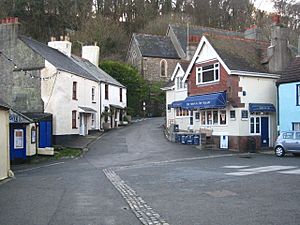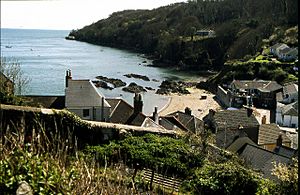Cawsand facts for kids
Quick facts for kids Cawsand
|
|
|---|---|
 The Square, Cawsand |
|
| Lua error in Module:Location_map at line 530: Unable to find the specified location map definition: "Module:Location map/data/Cornwall (mainland)" does not exist. | |
| OS grid reference | SX434502 |
| Civil parish |
|
| Unitary authority | |
| Ceremonial county | |
| Region | |
| Country | England |
| Sovereign state | United Kingdom |
| Post town | TORPOINT |
| Postcode district | PL10 |
| Dialling code | 01752 |
| Police | Devon and Cornwall |
| Fire | Cornwall |
| Ambulance | South Western |
| EU Parliament | South West England |
| UK Parliament |
|
Cawsand (which means Cow Cove in Cornish) is one of two twin villages in southeast Cornwall, England. The other village is Kingsand. These villages are located on the Rame Peninsula and are part of the parish of Maker-with-Rame.
Cawsand looks out over Plymouth Sound, a large natural harbor. It is right next to Kingsand. Long ago, the border between Devon and Cornwall used to run right through these villages. Now, the border is further away, along the River Tamar.
This charming village is inside Mount Edgcumbe Country Park. If you want to visit the city of Plymouth, which is about three miles north across Plymouth Sound, you can take a bus. In the summer, there's also a ferry service that goes from Cawsand Bay to Plymouth Hoe. Cawsand is also home to the Rame Gig Club, where people enjoy pilot gig rowing. The Rame Peninsula is sometimes called the "Forgotten Corner of Cornwall" because it's a bit hidden away.
Contents
Exploring Cawsand's Natural Beauty
Cawsand Beach is a mix of sand and small stones. It's a great place to explore because it has many rockpools when the tide goes out. These rockpools are like tiny aquariums, full of sea creatures.
A Look Back at Cawsand's Past
People first wrote about Cawsand in the year 1404. This means the settlement has been around for a very long time!
Defending the Village
In 1596, local people had to defend Cawsand from an attack by Spanish forces. After this, defenses were built to protect the village. Later, in the 1860s, a strong building called Cawsand Fort was constructed. This fort was part of a big plan to defend the United Kingdom. It was built on the site of an older battery from 1779. The fort had about 10 guns to guard the western entrance to Plymouth Sound.
The Ministry of Defence stopped using the fort in 1926. For many years, it was empty and falling apart. But now, it has been turned into homes.
Famous Visitors and Village Life
Records from the early 1800s show that Admiral Nelson, a very famous British naval hero, stayed in Cawsand. It's even rumored that he ate at a local pub called the Ship Inn. Sadly, this inn burned down in 2013 after being empty for some time. The area where it stood is now being rebuilt by a group called The Peninsula Trust. They plan to create a cafe and homes that people can afford.
Places of Worship in Cawsand
St Andrew's Church
St Andrew's Church was built between 1877 and 1878. It was created as a "chapel of ease," which means it was a smaller church built to serve people who lived far from the main parish church. This church is a Grade II listed building, meaning it's an important historic building.
Congregational Church
Cawsand also has a Congregational Church. This church was built even earlier, in 1793.
Cawsand's International Friends
Cawsand is twinned with a town called Porspoder in Brittany, France. This means the two communities have a special friendship and often share cultural exchanges.
Images for kids




